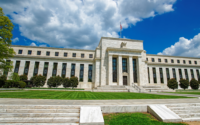U.S. Inflation Storm Prompts These Trade Ideas to Secure Returns
(Bloomberg) — An interest-rate and inflation climate unlike what many investors have ever seen is prompting them to look for assets to get through the market storm.
Most Read from Bloomberg
With U.S. inflation running at its hottest level since 1982 and swap traders now betting the Federal Reserve will increase rates by the equivalent of five quarter-points by the end of July, investors need to shield their portfolios from more stock and bond losses. Strategists are suggesting investments such as euro assets, gold and Asian resource company shares as alternatives.
One indication of the way surging consumer prices and expectations of monetary tightening are shaking up markets and risk assets can be seen in inflation-adjusted 10-year Treasury real yields, which have jumped to -0.421% Friday, the highest since June 2020.
“There is ample evidence and reasoned arguments that 10-year real rates will push up another ~50 basis points” and rise above zero, said Michael Purves, chief executive officer at Tallbacken Capital Advisors LLC. That move would come as “the Fed, and now the European Central Bank, continue to normalize their rate policies.”
Here are some ideas from strategists on what to do:
When It Slows
“Today’s CPI was hotter than expected and February’s print could be as well but again, it’s to what extent does it slow from here that should matter for markets,” said Peter Boockvar, chief investment officer at Bleakley Advisory Group. “I’ll use this as another opportunity to express my bullishness on gold and silver. From here, either the Fed will tighten too much and growth slows that results in the Fed backtracking and that will be bullish for gold or the Fed will still be too slow in tightening, real rates will remain firmly negative and that will be positive for gold.”
Kicking and Screaming
“Markets will kick and scream before taking their medicine but as long as a recession is not imminent, they can probably handle slightly higher rates without breaking down. Ultimately, there is still no alternative,” said Peter McGuire, chief executive officer of Trading Point, in a note. “Investors with nerves of steel can take advantage of the violent pullbacks to scale into positions for the long term, preferably in high-quality companies trading at a discount.”
Stocks Can Take It
“Stock markets can continue to nudge higher although we are not going to see the return that we saw last year,” said Karen Ward, chief market strategist for EMEA at J.P. Morgan Asset Management. “The economy still benefits from fiscal tailwinds. Earnings will be relatively resilient over the course of the year. As long as expectations for earnings are still moving up, as long as growth is resilient, then I think risk markets can absorb modestly higher interest rates.”
Real Rates
“A further increase in real rates does not have to mean a further surge in volatility and price/earnings contraction,” Tallbacken’s Purves wrote. “The Equity Risk Premium and nominal yields (and in particular the term premium on the back end of the curve) will be much more important for equity valuation. Further, if this rise in real rates is reflecting strong growth in both nominal and real GDP, then earnings growth should be robust. It should also be stated that there are several instances of markets — and P/Es — expanding in concert with real rates.”
A Silver Lining
“The sobering reality is that risk re-pricing will take some wind out of the sails, but the silver lining is that real U.S. rates remain sufficiently subdued for opportunistic and quick-footed bargain hunters,” said Vishnu Varathan, head of economics and strategy at Mizuho Bank Ltd. in Singapore. “I don’t expect a sustained meltdown in risk assets as a consequence of rising real yields just yet.”
Oversold Indicators
“The hot CPI print and market reaction ran over Wednesday’s pattern base buy signal for the 10-year note,” JPMorgan Chase & Co. strategists including Jay Barry, Jason Hunter and Phoebe White wrote in a note Thursday. “We suspect position and sentiment indicators will stretch closer to extreme oversold territory after today’s move. Nearby support parameters rest at 2.03%, 2.05%, and then 2.13%. At this point, the market would need to rally through 1.85-1.90% to confirm a short-term trend reversal.”
Long Euro
“The U.S. is now moving toward a late-cycle environment where Fed expectations are being repriced for ‘bad’ reasons: an environment of weak supply and high inflation is requiring the central bank to slow down growth,” George Saravelos, global head of FX research at Deutsche Bank AG, wrote in a note. “Putting it all together, incremental Fed rate hikes are looking increasingly less positive for the dollar going forward. Stay long EUR/USD.”
Tough Environment
“It will be a tough environment for risk assets until we get through the psychological impact of at least the first hike,” said Wai Ho Leong, strategist at Modular Asset Management in Singapore. “For Asia, inflation-linked bonds should perform better although liquidity tends to be challenging and limited to a few countries like Korea and Thailand. In equities, generally food, resources and energy companies should also do well. This is especially true in Malaysia, which is Asia’s only net exporter of energy and rubber glove products. We like the MYR a lot as an under-appreciated story.”
Asian Bonds
“The overnight blowout increase in UST yields will likely reverberate across regional bond markets,” said Winson Phoon, head of fixed-income research at Maybank Securities Pte in Singapore. “Yields should increase across the regional markets but still on a lower beta basis — i.e. correcting less than the UST move.”
He added that “China bonds should be more shielded from the UST volatility than other EM Asia markets. We expect the Indonesian government bond curve to bear-flatten in the next three to six months with the 5y10y curve flattening below 100 basis points.”
(Updates with J.P. Morgan Asset comment)
Most Read from Bloomberg Businessweek
©2022 Bloomberg L.P.
[ad_2]
Source link

